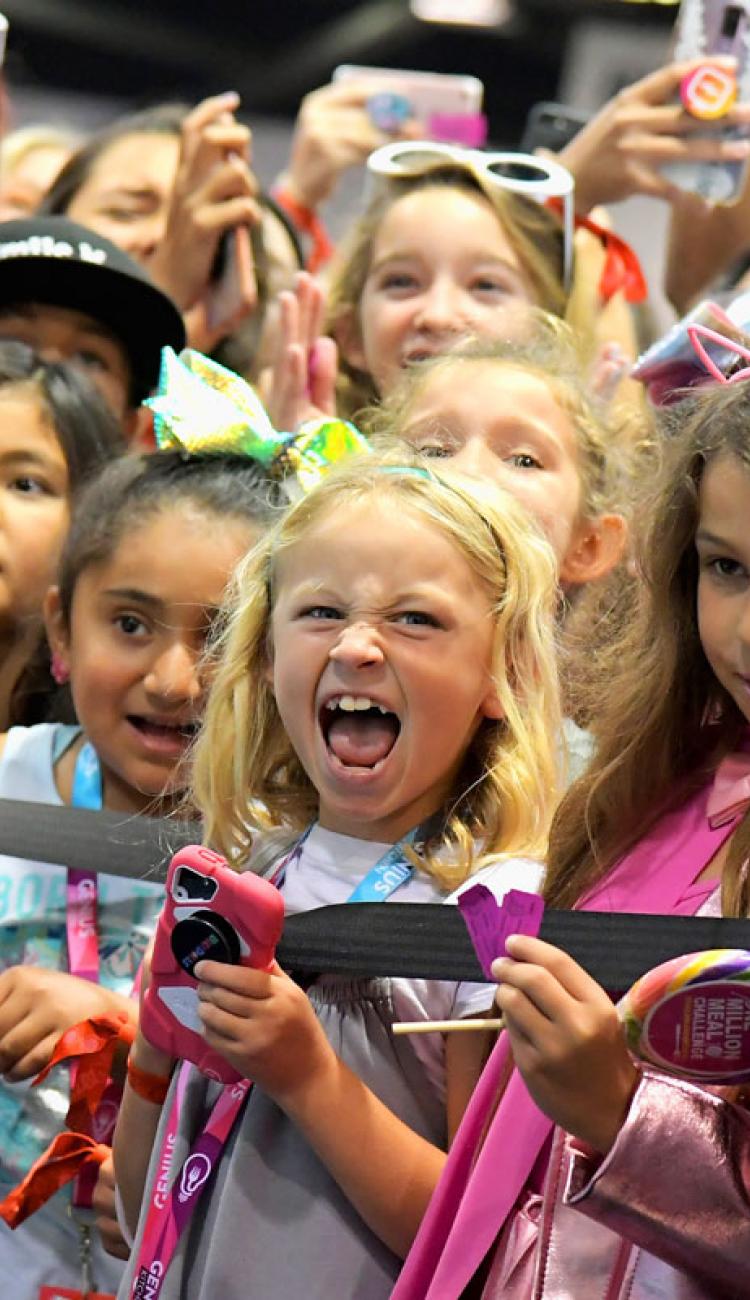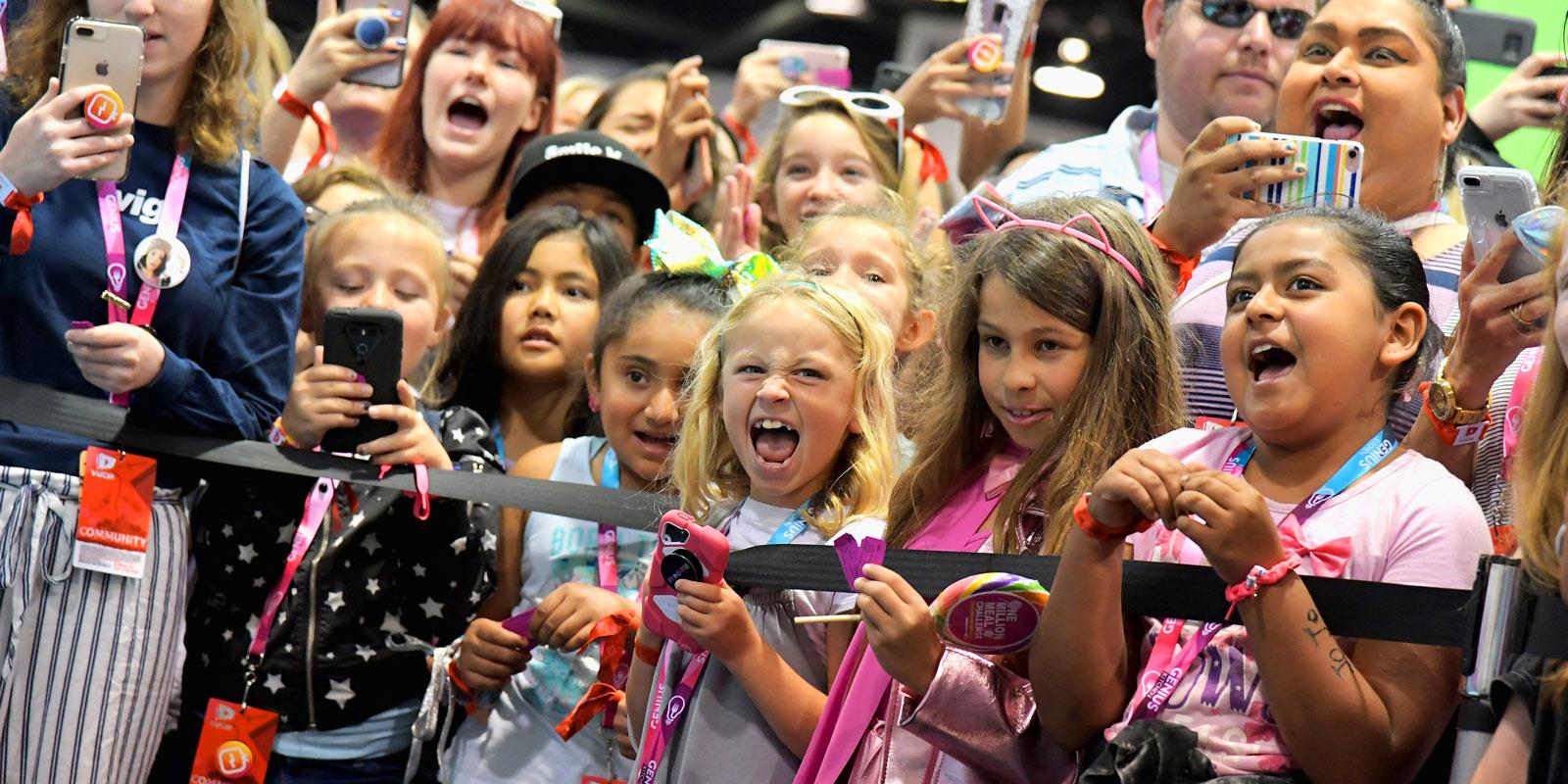Jun 25, 2018
An experience built for the “most media savvy audience in the world.”
The first level of VidCon at the Anaheim Convention Center is a lot to take in. There are dozens of activations causing tweens, teens and kids to scream as they snap a selfie while they wait for their slotted time to meet some the biggest stars of online video. For the die-hard fans—or community as they are called here—it’s a chance to be part of the action they usually stream.
VidCon, which ran from June 20 to June 23, covered several levels of the convention center, each level devoted to a different audience (creators, industry insiders, fans). Each floor emulated the chaotic and kismet-inducing point of the conference: to bring together all the groups of people involved in the booming business of online video in a scenario that was intrinsically shareable. It’s an evolution of the events that flourish in our so-called experience economy, catering to the digitally creative generation.
The crowd at VidCon could be mistaken for a trip full of people that missed the entrance to Disneyland across the street and stumbled in to the convention center. Parents with strollers, plus thousands of tweens, teens and 20-somethings in elaborate outfits, intricate makeup and creative clothing (think headbands with glitter antennas, pastel-colored hair, and leggings featuring a creator’s face).
“This is the most media savvy audience in the world,” Jim Louderback, CEO of VidCon, said as a family snapped a selfie in front of a giant YouTube logo/art installation. “They’re constantly snapping and tweeting and taking videos and posting and doing their stories and they’re doing it on these great brands that mean something to them. And that gets amplified all around the web because all their friends are then like, ‘OMG you’re at VidCon.’”
A Conscious Growth Strategy
The event was founded by brothers Hank and John Green in 2010, when they were familiar to most as YouTube personalities the Vlogbrothers. (John Green has since become known for penning “The Fault in Our Stars,” which became a bestseller in 2012.) The conference grew into a massive destination for fans of creators, creators and industry people trying to figure out how to monetize and innovate content created for many of the 11-year-old attendees, who spend most of their free time nose-deep in a smartphone.
Viacom purchased the conference earlier this year to provide even more power behind an already successful event. Roughly 30,000 people attended in 2017 and Louderback estimates it grew about 1,000 to 2,000 fans this year in a conscious effort to really grow into the space before building it out even further.
“We’ll be growing a lot next year. One of the nice things about working with Viacom is the Audience Science group,” said Louderback referencing Viacom’s team devoted to analytics, digital media, and audience segmentation. “So we’ll build out more activations and things to entertain more people and we’ll do a lot more marketing to drive ticket sales.”
Branded Success Through Activations
Brand presence also expanded this year, with more brands and bigger booths, but most attendees see the activations as part of the experience. Walking in, you couldn’t miss the massive brand signage visible from all angles. There was Nickelodeon, Facebook Watch, Hubert’s Lemonade, LEGO, Mars, Hasbro, Califia Farms and Cheez among the approximately 80 sponsor brands.
“I think everybody has their own opinion about brands, you know,” said Gina Tharin, 23, of Tennessee, using air quotes around the word “brands.”
“I don’t think it’s necessarily a bad thing,” she said about the massive brand presence as she waited in line for Cheez’s karaoke experience with a group of friends whom she met through YouTube. “It wouldn’t be nearly as good if [VidCon was] just based on ticket sales because they need to pay for everything and there are a lot of cool activities that are sponsored so I don’t mind that.”
According to Louderback, brand “activations that allow [attendees] to do things and capture your brand in some sort of video or a photo that’s pushed out to the internet, that’s how you create success as a brand here at VidCon.”
Hubert’s Lemonade set up a makeshift poolside resort with a ball-pit pool filled with yellow plastic balls imitating lemons. Parents lounged “poolside” while their children played games in the pit.
Facebook had multiple Instagram-worthy rooms as part of its activation to get people sharing photos on the platform. Mars Candy set up an entire village in the center of the hall.
Nickelodeon returned to sponsor the 10,500 square foot arcade complete with a Double Dare course and, of course, another Instagrammable opportunity with a “Teenage Mutant Ninja Turtle” wall. MTV Cribs also had a glamorous pastel apartment-like spot that drew in crowds looking for that perfect photo-worthy moment.
From Annual Event to Growth Engine
VidCon was also the place for new media giants, emerging platforms, and creators to announce new features or upcoming content to their most devoted audiences.
YouTube held a keynote in the event’s ballroom on the industry floor where it announced a monthly subscription tool for subscribers to a certain YouTube channel. The membership fee, enabling users to receive exclusive content, will cost $4.99 per month.
"We’re all about democratizing the creative economy; let’s bring everybody here and we’ll all interact."
Snapchat announced it would extend the Snapchat Shows video format, initially geared toward content providers like NBC, to creators. The first Snapchat Show of its kind will feature makeup artist Patrick Starrr (3.8 million followers on YouTube) offering makeup tutorials. Snap also said it would start sharing ad revenue with its creators.
Joey Graceffa’s YouTube Red Series “Escape the Night” held its Season 3 premiere at Vidcon and Nickelodeon amped up excitement for its upcoming “Teenage Mutant Ninja Turtle” series by creating selfie ops with a TMNT style wall and by allowing fans to go through the “Double Dare” obstacle course in anticipation of the new series on Monday night.
At the end of VidCon on Saturday night, Hank Green announced in his keynote that VidCon would award a $2,000 grant every week for the next year to an up-and-coming creator, who hasn’t yet reached the monetization level to allow them to hone their craft.
Louderback is interested in the idea of turning VidCon into a destination that extends beyond the conference center. (This year, one YouTuber, Tana Mongeau, decided to boycott VidCon and start her own YouTube conference. The conference, Tanacon, was shut down due to safety concerns after some 20,000 attendees showed up.)
“We’ve been doing this for nine years. We do a great job and people are building other things around us that aren’t stuff that we would do,” Louderback said. “We’re all about democratizing the creative economy; let’s bring everybody here and we’ll all interact.”

